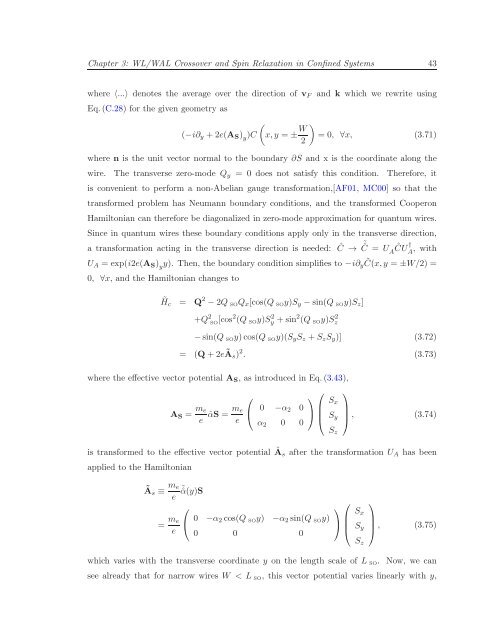Itinerant Spin Dynamics in Structures of ... - Jacobs University
Itinerant Spin Dynamics in Structures of ... - Jacobs University
Itinerant Spin Dynamics in Structures of ... - Jacobs University
Create successful ePaper yourself
Turn your PDF publications into a flip-book with our unique Google optimized e-Paper software.
Chapter 3: WL/WAL Crossover and <strong>Sp<strong>in</strong></strong> Relaxation <strong>in</strong> Conf<strong>in</strong>ed Systems 43<br />
where 〈...〉 denotes the average over the direction <strong>of</strong> v F and k which we rewrite us<strong>in</strong>g<br />
Eq.(C.28) for the given geometry as<br />
(−i∂ y +2e(A S ) y<br />
)C<br />
(<br />
x,y = ± W )<br />
= 0, ∀x, (3.71)<br />
2<br />
where n is the unit vector normal to the boundary ∂S and x is the coord<strong>in</strong>ate along the<br />
wire. The transverse zero-mode Q y = 0 does not satisfy this condition. Therefore, it<br />
is convenient to perform a non-Abelian gauge transformation,[AF01, MC00] so that the<br />
transformed problem has Neumann boundary conditions, and the transformed Cooperon<br />
Hamiltonian can therefore be diagonalized <strong>in</strong> zero-mode approximation for quantum wires.<br />
S<strong>in</strong>ce <strong>in</strong> quantum wires these boundary conditions apply only <strong>in</strong> the transverse direction,<br />
a transformation act<strong>in</strong>g <strong>in</strong> the transverse direction is needed: Ĉ → ˜Ĉ = U A ĈU † A , with<br />
U A = exp(i2e(A S ) y<br />
y). Then, the boundary condition simplifies to −i∂ y ˜C(x,y = ±W/2) =<br />
0, ∀x, and the Hamiltonian changes to<br />
˜H c = Q 2 −2Q SO Q x [cos(Q SO y)S y −s<strong>in</strong>(Q SO y)S z ]<br />
+Q 2 SO [cos2 (Q SO y)Sy 2 +s<strong>in</strong>2 (Q SO y)Sz<br />
2<br />
−s<strong>in</strong>(Q SO y)cos(Q SO y)(S y S z +S z S y )] (3.72)<br />
= (Q+2eàs ) 2 . (3.73)<br />
where the effective vector potential A S , as <strong>in</strong>troduced <strong>in</strong> Eq.(3.43),<br />
A S = m e<br />
e ˆαS = m e<br />
e<br />
⎛<br />
⎝ 0 −α 2 0<br />
α 2 0 0<br />
⎛ ⎞<br />
⎞ S x<br />
⎠⎜<br />
⎝ S y<br />
S z<br />
⎟<br />
⎠ , (3.74)<br />
is transformed to the effective vector potential às after the transformation U A has been<br />
applied to the Hamiltonian<br />
à s ≡ m e<br />
e ˜ˆα(y)S<br />
⎛<br />
= m e<br />
e<br />
⎝ 0 −α 2cos(Q SO y) −α 2 s<strong>in</strong>(Q SO y)<br />
0 0 0<br />
⎛<br />
⎞<br />
⎠⎜<br />
⎝<br />
⎞<br />
S x<br />
S y<br />
⎟<br />
⎠ , (3.75)<br />
S z<br />
which varies with the transverse coord<strong>in</strong>ate y on the length scale <strong>of</strong> L SO . Now, we can<br />
see already that for narrow wires W < L SO , this vector potential varies l<strong>in</strong>early with y,
















